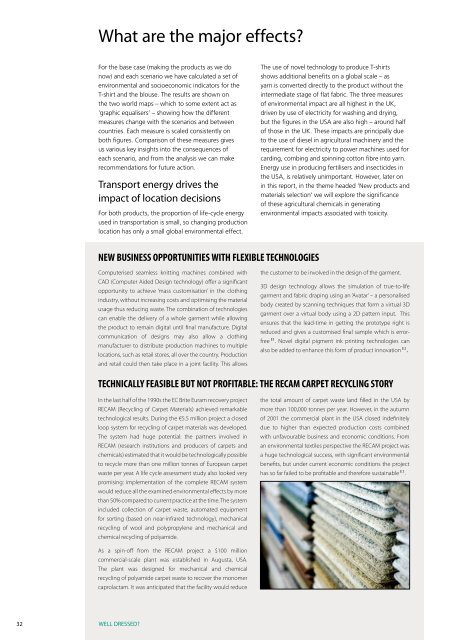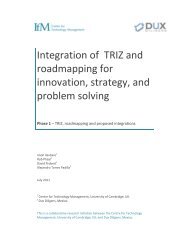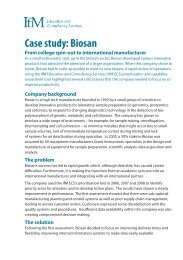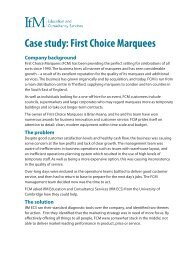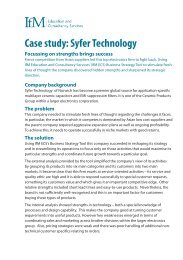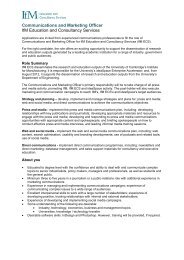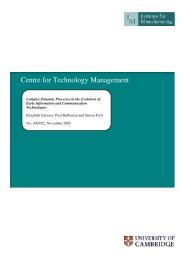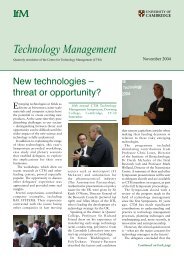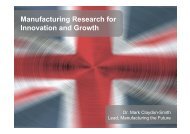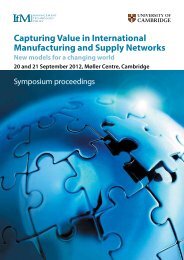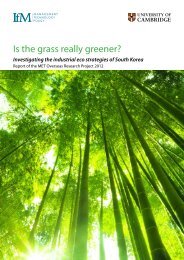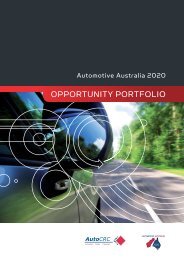The present and future sustainability of clothing and textiles in the ...
The present and future sustainability of clothing and textiles in the ...
The present and future sustainability of clothing and textiles in the ...
Create successful ePaper yourself
Turn your PDF publications into a flip-book with our unique Google optimized e-Paper software.
What are <strong>the</strong> major effects?<br />
For <strong>the</strong> base case (mak<strong>in</strong>g <strong>the</strong> products as we do<br />
now) <strong>and</strong> each scenario we have calculated a set <strong>of</strong><br />
environmental <strong>and</strong> socioeconomic <strong>in</strong>dicators for <strong>the</strong><br />
T-shirt <strong>and</strong> <strong>the</strong> blouse. <strong>The</strong> results are shown on<br />
<strong>the</strong> two world maps – which to some extent act as<br />
‘graphic equalisers’ – show<strong>in</strong>g how <strong>the</strong> different<br />
measures change with <strong>the</strong> scenarios <strong>and</strong> between<br />
countries. Each measure is scaled consistently on<br />
both figures. Comparison <strong>of</strong> <strong>the</strong>se measures gives<br />
us various key <strong>in</strong>sights <strong>in</strong>to <strong>the</strong> consequences <strong>of</strong><br />
each scenario, <strong>and</strong> from <strong>the</strong> analysis we can make<br />
recommendations for <strong>future</strong> action.<br />
Transport energy drives <strong>the</strong><br />
impact <strong>of</strong> location decisions<br />
For both products, <strong>the</strong> proportion <strong>of</strong> life-cycle energy<br />
used <strong>in</strong> transportation is small, so chang<strong>in</strong>g production<br />
location has only a small global environmental effect.<br />
<strong>The</strong> use <strong>of</strong> novel technology to produce T-shirts<br />
shows additional benefits on a global scale – as<br />
yarn is converted directly to <strong>the</strong> product without <strong>the</strong><br />
<strong>in</strong>termediate stage <strong>of</strong> flat fabric. <strong>The</strong> three measures<br />
<strong>of</strong> environmental impact are all highest <strong>in</strong> <strong>the</strong> UK,<br />
driven by use <strong>of</strong> electricity for wash<strong>in</strong>g <strong>and</strong> dry<strong>in</strong>g,<br />
but <strong>the</strong> figures <strong>in</strong> <strong>the</strong> USA are also high – around half<br />
<strong>of</strong> those <strong>in</strong> <strong>the</strong> UK. <strong>The</strong>se impacts are pr<strong>in</strong>cipally due<br />
to <strong>the</strong> use <strong>of</strong> diesel <strong>in</strong> agricultural mach<strong>in</strong>ery <strong>and</strong> <strong>the</strong><br />
requirement for electricity to power mach<strong>in</strong>es used for<br />
card<strong>in</strong>g, comb<strong>in</strong>g <strong>and</strong> sp<strong>in</strong>n<strong>in</strong>g cotton fibre <strong>in</strong>to yarn.<br />
Energy use <strong>in</strong> produc<strong>in</strong>g fertilisers <strong>and</strong> <strong>in</strong>secticides <strong>in</strong><br />
<strong>the</strong> USA, is relatively unimportant. However, later on<br />
<strong>in</strong> this report, <strong>in</strong> <strong>the</strong> <strong>the</strong>me headed ‘New products <strong>and</strong><br />
materials selection’ we will explore <strong>the</strong> significance<br />
<strong>of</strong> <strong>the</strong>se agricultural chemicals <strong>in</strong> generat<strong>in</strong>g<br />
environmental impacts associated with toxicity.<br />
New bus<strong>in</strong>ess opportunities with flexible technologies<br />
Computerised seamless knitt<strong>in</strong>g mach<strong>in</strong>es comb<strong>in</strong>ed with<br />
CAD (Computer Aided Design technology) <strong>of</strong>fer a significant<br />
opportunity to achieve ‘mass customisation’ <strong>in</strong> <strong>the</strong> <strong>cloth<strong>in</strong>g</strong><br />
<strong>in</strong>dustry, without <strong>in</strong>creas<strong>in</strong>g costs <strong>and</strong> optimis<strong>in</strong>g <strong>the</strong> material<br />
usage thus reduc<strong>in</strong>g waste. <strong>The</strong> comb<strong>in</strong>ation <strong>of</strong> technologies<br />
can enable <strong>the</strong> delivery <strong>of</strong> a whole garment while allow<strong>in</strong>g<br />
<strong>the</strong> product to rema<strong>in</strong> digital until f<strong>in</strong>al manufacture. Digital<br />
communication <strong>of</strong> designs may also allow a <strong>cloth<strong>in</strong>g</strong><br />
manufacturer to distribute production mach<strong>in</strong>es to multiple<br />
locations, such as retail stores, all over <strong>the</strong> country. Production<br />
<strong>and</strong> retail could <strong>the</strong>n take place <strong>in</strong> a jo<strong>in</strong>t facility. This allows<br />
<strong>the</strong> customer to be <strong>in</strong>volved <strong>in</strong> <strong>the</strong> design <strong>of</strong> <strong>the</strong> garment.<br />
3D design technology allows <strong>the</strong> simulation <strong>of</strong> true-to-life<br />
garment <strong>and</strong> fabric drap<strong>in</strong>g us<strong>in</strong>g an ‘Avatar’ – a personalised<br />
body created by scann<strong>in</strong>g techniques that form a virtual 3D<br />
garment over a virtual body us<strong>in</strong>g a 2D pattern <strong>in</strong>put. This<br />
ensures that <strong>the</strong> lead-time <strong>in</strong> gett<strong>in</strong>g <strong>the</strong> prototype right is<br />
reduced <strong>and</strong> gives a customised f<strong>in</strong>al sample which is errorfree<br />
E1 . Novel digital pigment <strong>in</strong>k pr<strong>in</strong>t<strong>in</strong>g technologies can<br />
also be added to enhance this form <strong>of</strong> product <strong>in</strong>novation E2 .<br />
Technically feasible but not pr<strong>of</strong>itable: <strong>the</strong> recam carpet recycl<strong>in</strong>g story<br />
In <strong>the</strong> last half <strong>of</strong> <strong>the</strong> 1990s <strong>the</strong> EC Brite Euram recovery project<br />
RECAM (Recycl<strong>in</strong>g <strong>of</strong> Carpet Materials) achieved remarkable<br />
technological results. Dur<strong>in</strong>g <strong>the</strong> €5.5 million project a closed<br />
loop system for recycl<strong>in</strong>g <strong>of</strong> carpet materials was developed.<br />
<strong>The</strong> system had huge potential: <strong>the</strong> partners <strong>in</strong>volved <strong>in</strong><br />
RECAM (research <strong>in</strong>stitutions <strong>and</strong> producers <strong>of</strong> carpets <strong>and</strong><br />
chemicals) estimated that it would be technologically possible<br />
to recycle more than one million tonnes <strong>of</strong> European carpet<br />
waste per year. A life cycle assessment study also looked very<br />
promis<strong>in</strong>g: implementation <strong>of</strong> <strong>the</strong> complete RECAM system<br />
would reduce all <strong>the</strong> exam<strong>in</strong>ed environmental effects by more<br />
than 50% compared to current practice at <strong>the</strong> time. <strong>The</strong> system<br />
<strong>in</strong>cluded collection <strong>of</strong> carpet waste, automated equipment<br />
for sort<strong>in</strong>g (based on near-<strong>in</strong>frared technology), mechanical<br />
recycl<strong>in</strong>g <strong>of</strong> wool <strong>and</strong> polypropylene <strong>and</strong> mechanical <strong>and</strong><br />
chemical recycl<strong>in</strong>g <strong>of</strong> polyamide.<br />
<strong>the</strong> total amount <strong>of</strong> carpet waste l<strong>and</strong> filled <strong>in</strong> <strong>the</strong> USA by<br />
more than 100,000 tonnes per year. However, <strong>in</strong> <strong>the</strong> autumn<br />
<strong>of</strong> 2001 <strong>the</strong> commercial plant <strong>in</strong> <strong>the</strong> USA closed <strong>in</strong>def<strong>in</strong>itely<br />
due to higher than expected production costs comb<strong>in</strong>ed<br />
with unfavourable bus<strong>in</strong>ess <strong>and</strong> economic conditions. From<br />
an environmental <strong>textiles</strong> perspective <strong>the</strong> RECAM project was<br />
a huge technological success, with significant environmental<br />
benefits, but under current economic conditions <strong>the</strong> project<br />
has so far failed to be pr<strong>of</strong>itable <strong>and</strong> <strong>the</strong>refore susta<strong>in</strong>able E3 .<br />
As a sp<strong>in</strong>-<strong>of</strong>f from <strong>the</strong> RECAM project a $100 million<br />
commercial-scale plant was established <strong>in</strong> Augusta, USA.<br />
<strong>The</strong> plant was designed for mechanical <strong>and</strong> chemical<br />
recycl<strong>in</strong>g <strong>of</strong> polyamide carpet waste to recover <strong>the</strong> monomer<br />
caprolactam. It was anticipated that <strong>the</strong> facility would reduce<br />
32 WELL DRESSED?


